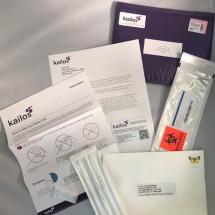Metabolism of Medication is Personal
Due to naturally occurring variations in our genes, people metabolize, or process, certain medications at different rates. The study of how efficiently people are able to metabolize medication is called pharmacogenetics. Pharmacogenetics categorizes this efficiency into 4 metabolic statuses for the breakdown of a particular medication:
- Poor metabolizers (PM) - very slow breakdown
- Intermediate metabolizers (IM) - slower than normal breakdown
- Normal metabolizers (NM) - normal breakdown
- Ultra-rapid metabolizers (UM) - faster than normal breakdown

Kailos Genetics’ InspexionTM pharmacogenetic test categorizes key genes involved in the breakdown of medications into these 4 metabolic statuses. These pharmacogenes regulate the metabolism of a variety of medications used to treat a wide range of conditions such as cancer, chronic pain, high blood pressure and mental health issues. Understanding how a patient processes medication enables healthcare professionals to prescribe optimized medication and dosages, increasing the likelihood that you will feel better sooner.
Of these pharmacogenes, CYP2D6 has been studied extensively due to its involvement in the metabolism of many opioid pain relievers such as codeine. Codeine is broken down, in part, by the CYP2D6 gene product into morphine and other compounds. The pain relief felt by a patient taking codeine is due to the breakdown of codeine into morphine. Patients with nonfunctional or poorly functioning CYP2D6 genes do not break down codeine well and therefore get little to no pain relief. These patients are referred to as “Poor Metabolizers” (PM). On the other end of the spectrum are patients with higher than normal CYP2D6 gene activity, referred to as “Ultra-Rapid Metabolizers” (UM). UMs break codeine down more efficiently than the general population which can result in toxic levels of morphine after taking what is considered a normal dose of codeine for Normal Metabolizers (NM).
Toxic levels of morphine can be fatal if not detected and treated quickly. Tragically, there have been documented cases of pediatric patients dying from respiratory depression after taking normal doses of codeine following tonsillectomies. These children were later found to be CYP2D6 UMs which resulted in toxic levels of morphine from recommended doses of codeine.1 In response to these cases, the FDA no longer recommends codeine for pain relief in children after tonsillectomy.2 Tramadol, another opioid, was thought to be a safer alternative to codeine in CYP2D6 UMs and was recommended as a replacement drug. Unfortunately, the following case study illustrates that tramadol was not a safer alternative.
A five-year-old boy, Connor,3 underwent a tonsillectomy to treat his obstructive sleep apnea syndrome (OSAS). After an uneventful surgery and postoperative stay of six hours, Connor was discharged home with his parents. Approximately eight hours after leaving the hospital, Connor complained of increasing pain. He received one oral dose of tramadol as prescribed by his physician. The next morning, his parents found him lethargic and immediately brought him back to the hospital. By the time they arrived at the emergency room, Connor was comatose and barely breathing. He was transferred to the pediatric intensive care unit, put on noninvasive ventilation and treated with naloxone, a medication used to quickly reverse opioid overdose. Within minutes Connor regained consciousness and was breathing normally. Connor underwent pharmacogenetic testing and was found to be a CYP2D6 UM.4 In 2017, the FDA issued a new warning against the use of codeine or tramadol in children, teens and breastfeeding women,5 which will prevent future accidental opioid overdoses in children and teens. Importantly however, Connor’s status as a CYP2D6 UM will not change throughout his lifetime, and therefore any physician treating Connor as an adult must consider his CYP2D6 UM status when prescribing pain relief medications in order to avoid future life-threatening opioid overdoses.
Our case study illustrates the utility of pharmacogenetic testing in avoiding negative medication reactions. The Kailos Genetics’ Inspexion pharmacogenetic test uses next generation sequencing technology to report the metabolic status of many of your key pharmacogenetic genes. The information learned through this test enables your physician to tailor both your medications and dosages based on your specific gene variations.
Please note that medications should never be adjusted based on pharmacogenetic testing results without first consulting your healthcare professional.

We extract your DNA for testing from a simple, painless oral swab collection kit that can be performed yourself in the comfort of your own home. After testing is complete, you and your designated healthcare provider will have access to your metabolic status results to guide future treatment. Kailos Genetics understands that precision medicine is all about the health and safety of the patient.




